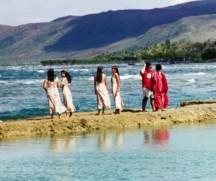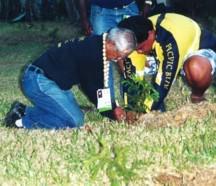Digital Collections
Celebrating the breadth and depth of Hawaiian knowledge. Amplifying Pacific voices of resiliency and hope. Recording the wisdom of past and present to help shape our future.
Kīhei de Silva
Kīhei de Silva’s text of "Poneliwena" (the name is a Hawaiianization of the New Caledonian place-name Ponerihouen) includes the following introduction: "This mele was inspired by the Hawai‘i delegation’s reception at Ponerihouen, Northern Province, New Caledonia, where we and the delegates of Papua New Guinea were welcomed, fed, and entertained by the Kanak people of this district, some of whom—we later learned—had walked for two days to reach the oceanside clearing at which we performed. At the end of a day of increasingly friendly sharing, we were invited to join our hosts in the pilou, a traditional Kanak dance, after which we were asked to commemorate our visit by planting a row of pine trees along the roadside leading away from the site. Pine trees, we had learned earlier, have great ceremonial importance to the Kanak. "These trees," said one of our hosts in his farewell speech, "will call you back to us. We will remember you through these trees; our children will use these trees to tell their children about your visit."
Kau aku ka mana‘o no Poneliwena
ʻĀina kāhela molale i ka la‘i
Ho‘ohihi i ke kani o ka hula pilu
Ua mau akula i ka pō me ke ao
Aloha ‘ia nō ke kumu lā‘au paina
He hō‘ailona ia na ke kupuna
‘Oiai he mau kaukani mile ka mamao
E kolo nō ke ēwe i ka ‘iewe
Ha‘ina ‘ia mai ana ka puana
Kau aku ka mana‘o no Poneliwena
My thoughts rest at Ponerihouen
A land spread out, unobstructed in the calm
We are entranced by the sound of the pilou dance
That goes on night and day
Beloved are the pine trees
They are signs left by the ancestors
Although we are thousands of miles distant
The afterbirth creeps to the afterbirth
Tell the summary of the song:
My thoughts rest at Ponerihouen.
© Kihei de Silva, 2000

photo credit: Kīhei de Silva
‘Āina kāhela molale i ka la‘i – A land spread out, unobstructed in the calm. Hawaiians with strong memories of the Punalu‘u and Hau‘ula of 40 years ago agreed that Ponerihouen bears considerable resemblance to those old east O‘ahu communities.

photo credit: Kīhei de Silva
‘Anakala Eddie Ka‘anana and Mauri Maihuri take part in a tree planting ceremony by which the delegation’s visit will be remembered beyond the life spans of its individual members. For the Kanaks, pine trees are symbolic of ancestral connections; in planting these trees, Hawai‘i reconnects with its Melanesian cousins, kanaka to kanak, tree root to tree root, ēwe to ‘iewe.